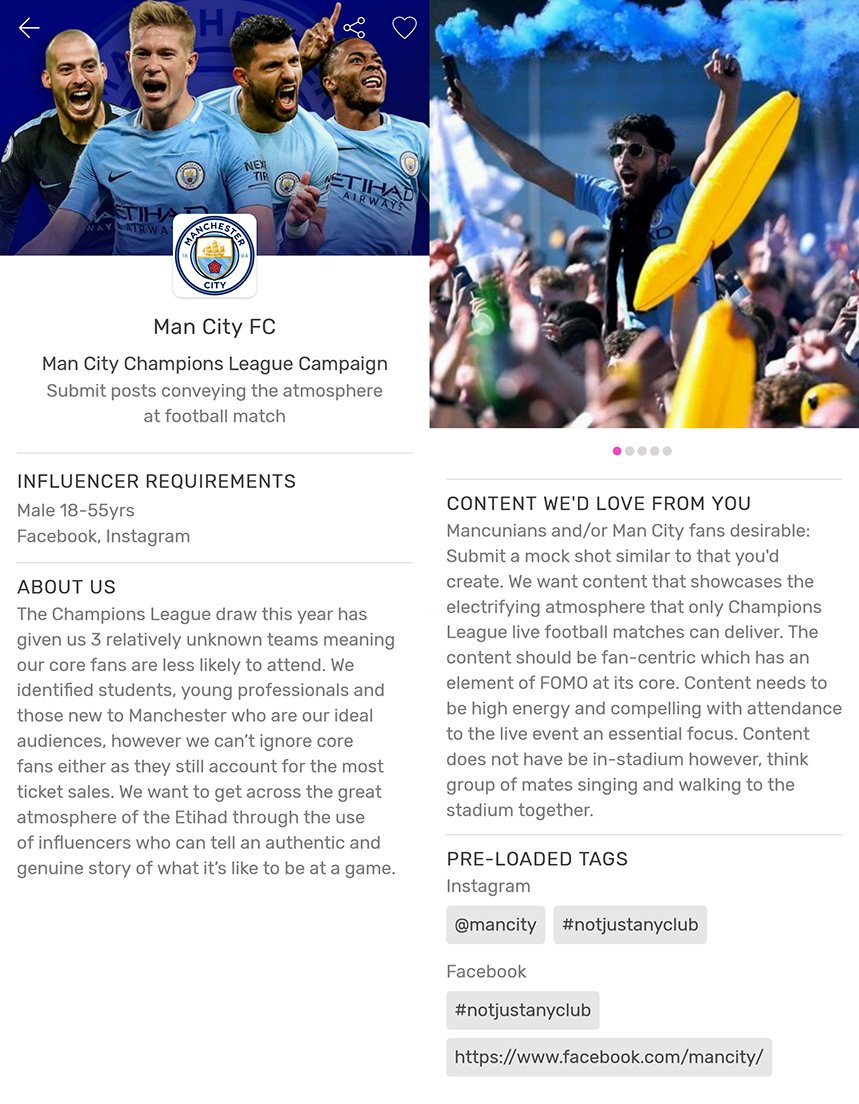Manchester City’s Poorly Executed Influencer Campaign Highlights A Wider Sports Marketing Phenomenon

Manchester City FC’s recent attempt to hire Facebook and Instagram influencers to create content on behalf of the club was not only shamed by the public online it has also shed some light on a wider sports marketing phenomenon.
The soccer giant, which competes in the English Premier League, posted an advert on Tribe, a platform that connects brands to people with large social media followings, looking for influencers to create fan-centric content that would instil a sense of FOMO – Fear Of Missing Out, so that students, young professionals and Manchester newcomers might be stirred to attend City’s European home fixtures.
As absurd as that may sound, it isn’t actually an unfamiliar marketing ploy in sport at the moment, but more on that later.

The post also referred to the Premier League club’s group stage opponents – Italy’s Atalanta, Croatian side Dinamo Zagreb and Shakhtar Donetsk of Ukraine – as three ‘relatively unknown teams’.
But perhaps the most damaging, was the fact that City appeared to be planning for the absence of their ‘core fans’ during their Champions League campaign – which is often boycotted by fans due to the notoriously frosty relationship with Uefa.
Only apparently it wasn’t, as City was quick to distance themselves from the post, stating that it was created without their knowledge or permission and within a few days, the club had severed ties with PHD Media Manchester, the agency responsible for the blunder.
A statement later issued by Jon Kershaw, PHD Media Manchester’s managing director, read: ‘The brief we issued to a third-party supplier, Tribe, fell short of the high standards that PHD Manchester is committed to delivering for its clients and we regret any negative impact on Manchester City FC.’
But, by that point, the damage had been done, the fact that City, by essentially advertising for artificial fans, seemed to be openly acknowledging those problems was embarrassing press for both them and their supporters.
Despite the poor execution in this particular scenario, the sports industry has already been incorporating this strategy for a number of years.
According to a 2019 study from Cascade Influencers, which surveyed marketers from franchises in the NHL, NBA, NFL, MLB and CFL, 45 per cent of teams increased their influencer marketing budget last year, with nearly 25 per cent spending more than US$20,000 on influencer programmes.
Their reasons for doing so are clear with 42 per cent saying they track follower growth more than any other metric to gauge the success of such programmes.
The proliferation of micro-influencers has become a familiar sight at major sporting events, and Jamie King, social and digital content manager for NFL UK, told SportsPro earlier this year that the league’s UK operation now engages 200 to 300 micro-influencers each year, with those creators having anywhere between 5,000 and 100,000 followers.
So as it turns out, Manchester City isn’t the only club employing this strategy to widen their net, but unfortunately for the Premier League champions, they will now become a case study for the risks of doing so.
It's free to join the team!
Join the most engaged community in the Sports Business World.
Get all the latest news, insights, data, education and event updates.






